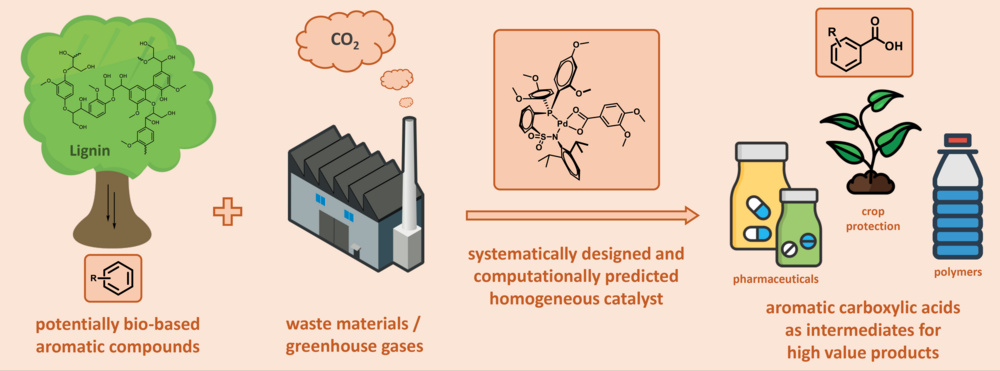Aromatic carboxylic acids are highly important products of the chemical industry with applications in plastics, herbicides, or medicine. Salicylic acid (“Aspirin”) is among the most well known examples. It is far less known, however, that salicylic acid is produced using carbon dioxide (CO2) as feedstock. Formally, The CO2 molecule is inserted into the C-H bond of the aromatic substance phenol to generate the product in a process known as the Kolbe-Schmitt reaction. A research team around Walter Leitner and colleagues at RWTH Aachen has now developed a novel catalytic reaction that enables this synthetic principle to be applied for a broad range of other aromatic substrates including feedstocks derived from biomass (Science Advances 2023, 9(5), DOI: 10.1126/sciadv.adf29).
The quest for a catalyst to open this new pathway was a long journey. Walter Leitner and his colleague Markus Hölscher had proposed a hypothetical catalytic mechanism for the molecular transformation already a number of years ago, but finding a novel catalyst for a unprecedented reaction by trial and error seemed like the search for the needle in the haystack. Therefore, they took a different approach. Dr. Hölscher, an expert in computational chemistry, systematically analyzed the feasibility of the proposal with calculations and the validity of the data was verified step-by-step experimentally. Finally, a promising lead structure could be identified and Gregor Kemper - then a PhD student in Aachen, now Postdoc at the MPI CEC – undertook the challenge to synthesize the predicted candidate. The catalyst is a molecular coordination compound comprising palladium as metal center surrounded by a specifically designed ligand as derived from the calculations. And sure enough, the predictions proved valid: the complex was able to activate the C-H bond, insert the CO2 into the resulting Palladium-carbon bond, and liberate the carboxylic acid to regenerate the active species. More than 100 of such catalytic turnovers were possible in favorable cases and the synthetic potential of the new reaction could be demonstrated for a range of interesting targets including veratric acid, an important intermediate of the pharmaceutical industry, from biomass derived veratrol and CO2 as raw materials.
The new reaction opens very attractive pathways to important products using carbon dioxide from waste streams or even from the atmosphere together with bio-based feedstocks. While the catalytic efficiency needs further improvements to make this viable for industrial production, the de novo development of a catalyst to achieve an unprecedented reaction with CO2 demonstrates the power of “catalyst design” using computational methods. Following the Max Planck motto “insight must precede application”, further research in this direction appears now highly promising!

